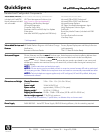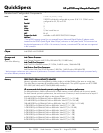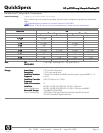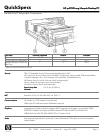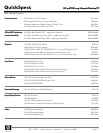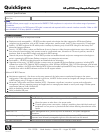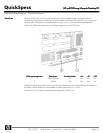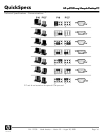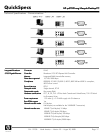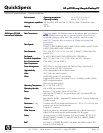
Optical Drive Spins Down When
Not In Use
Yes
NOTES
NOTESNOTES
NOTES
:
* This 80% efficient power supply is a requirement for ENERGY STAR compliance in conjunction with a select range of processors
and modules.
** Power consumption in the Off/Apparent Off mode is measured and reported with the network interface controller "Wake on LAN"
feature disabled in F10 Setup (default is "enabled").
ROM BIOS Information
ROM BIOS InformationROM BIOS Information
ROM BIOS Information
Key features of the HP BIOS in the rp5700 include:
Deployment and manageability – HP BIOS provides several technologies that help integrate the HP Business Desktop
computer into the enterprise, such as PXE, remote configuration, remote control, and F10 Setup support for 12 languages.
Stability – HP BIOS supports the HP stable product roadmap by releasing only critical BIOS changes to the factory and
advanced change notification.
Security – HP BIOS offers a robust and flexible set of security features to help the system administrator secure their systems
from removal of sensitive data, help prevent access by unauthorized users, subversion of OS security policies, removal of
hardware, flash of rogue BIOS images, and attacks on BIOS settings.
Thermal and power management – The HP BIOS provides and enables thermal and power management technologies to
assist in operating the HP Business Desktop computer in any enterprise environment.
Serviceability – HP BIOS provides diagnostic and detailed service information.
Upgrades and recovery – HP BIOS provides numerous ways to upgrade HP Business Desktop computers, including BIOS
updates from within DOS (Flashlite), BIOS updates from within Windows (HPQFlash, SSM), HP Client Manager, and fail-safe
recovery. In addition, the HP Business Desktop BIOS Utilities tool enables replicated BIOS setup throughout the Enterprise; it is
available from within the BIOS software and from the HP support website.
Additional HP BIOS Features
Administrator password – Also known as the setup password, this helps prevent unauthorized changes to the system
configuration. If the administrator password is not known, the BIOS version cannot be changed and changes cannot be made
to BIOS settings using F10 setup or under the OS.
Advanced Configuration and Power Interface (ACPI) – Represents a significant innovation in power and configuration
management, allowing operating systems and applications to manage power based on activity and usage. Provides power
conservation features under Windows XP.
Ability to disable the internal speaker
Ability to disable USB ports
Other Features
Other FeaturesOther Features
Other Features
Description
DescriptionDescription
Description
ACPI-Ready Hardware
Advanced Configuration and Power Management Interface (ACPI).
Allows the system to wake from a low power mode.
Controls system power consumption, making it possible to place individual cards and
peripherals in a low-power or powered-off state without affecting other elements of the
system.
SMBIOS Ver. 2.4
System Management BIOS, previously known as DMI BIOS, for system management
information
Wired for Management Support
Intel-driven, industry-wide initiative to make Intel architecture-based PCs, servers and mobile
computers more inherently manageable right out of the box and over the network
Dual-State Power Button
Power button acts as both an on/off button and suspend-to-sleep button
QuickSpecs
HP rp5700 Long Lifecycle Desktop PC
HP rp5700 Long Lifecycle Desktop PCHP rp5700 Long Lifecycle Desktop PC
HP rp5700 Long Lifecycle Desktop PC
Technical Specifications
DA - 12758 North America — Version 18 — August 20, 2008
Page 12



